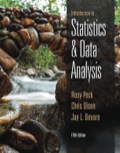
The article “Tobacco and Alcohol Use in G-Rated Children’s Animated Films” (Journal of the American Medical Association [1999]: 1131–1136) reported exposure to tobacco and alcohol use in all G-rated animated films released between 1937 and 1997 by five major film studios. The researchers found that tobacco use was shown in 56% of the reviewed films. Data on the total tobacco exposure time (in seconds) for films with tobacco use produced by Walt Disney, Inc., were as follows:

Data for 11 G-rated animated films showing tobacco use that were produced by MGM/United Artists, Warner Brothers, Universal, and Twentieth Century Fox were also given. The tobacco exposure times (in seconds) for these films was as follows:

- a. Construct a comparative stem-and-leaf display for these data.
- b. Comment on the interesting features of this display.
Want to see the full answer?
Check out a sample textbook solution
Chapter 3 Solutions
Introduction to Statistics and Data Analysis
Additional Math Textbook Solutions
Elementary Statistics: Picturing the World (6th Edition)
Statistics for Engineers and Scientists
Introductory Statistics
Probability and Statistics for Engineering and the Sciences
Statistics for Business & Economics, Revised (MindTap Course List)
Elementary Statistics: A Step By Step Approach
 Functions and Change: A Modeling Approach to Coll...AlgebraISBN:9781337111348Author:Bruce Crauder, Benny Evans, Alan NoellPublisher:Cengage Learning
Functions and Change: A Modeling Approach to Coll...AlgebraISBN:9781337111348Author:Bruce Crauder, Benny Evans, Alan NoellPublisher:Cengage Learning Glencoe Algebra 1, Student Edition, 9780079039897...AlgebraISBN:9780079039897Author:CarterPublisher:McGraw Hill
Glencoe Algebra 1, Student Edition, 9780079039897...AlgebraISBN:9780079039897Author:CarterPublisher:McGraw Hill Holt Mcdougal Larson Pre-algebra: Student Edition...AlgebraISBN:9780547587776Author:HOLT MCDOUGALPublisher:HOLT MCDOUGAL
Holt Mcdougal Larson Pre-algebra: Student Edition...AlgebraISBN:9780547587776Author:HOLT MCDOUGALPublisher:HOLT MCDOUGAL Big Ideas Math A Bridge To Success Algebra 1: Stu...AlgebraISBN:9781680331141Author:HOUGHTON MIFFLIN HARCOURTPublisher:Houghton Mifflin Harcourt
Big Ideas Math A Bridge To Success Algebra 1: Stu...AlgebraISBN:9781680331141Author:HOUGHTON MIFFLIN HARCOURTPublisher:Houghton Mifflin Harcourt



